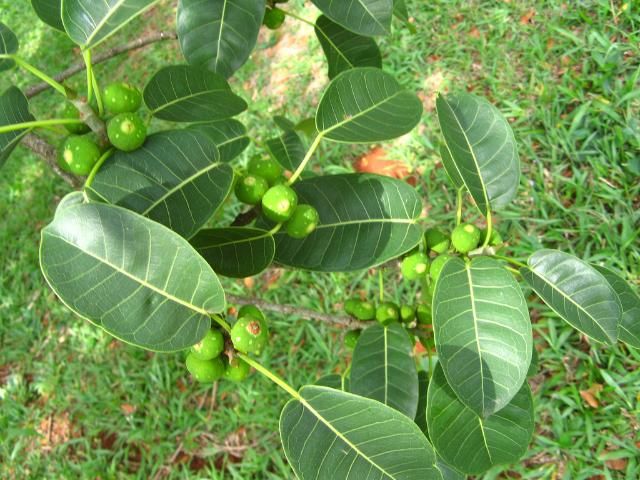Family
Moraceae, mulberry family.
Genus
Ficus is the ancient Latin word for "fig."
Species
The species name, citrifolia, a combination of the Latin prefix citri, meaning "citron-like," and the Latin suffix folia, meaning "leaved," describes the tree's leaves, which look similar to those of many citrus species.
Common Name
Shortleaf Fig, Wild Banyantree
The common name "shortleaf fig" is based on the relatively short length of the leaves compared to other fig species.
Description
This semi-deciduous fig tree is native to Florida and is naturally found in tropical hammocks throughout south Florida, the Caribbean, the Bahamas, the West Indies, and some regions in Central America, such as Belize and the Yucatan. It requires full sun for optimal growth and can reach heights between 40 to 50 feet. Leaves are simple, alternate, and range from 2 to 4 inches long. The leaf appears oval but the base of the leaf is rounded and the tip of the leaf is sharply pointed. Leaves are dark green and smooth with a leathery texture and entire or smooth margin. A shortleaf fig's trunk can grow to a diameter of 2 feet or greater, and its bark is light to yellowish brown. Blooms are inconspicuous, occurring inside of figs. Fruits appear on elongated stalks, are ¼ to ½ inch in diameter, and turn from yellow to purple when ripe.

Credit: mauroguanandi, CC BY 2.0
Allergen
Though related to mulberries (known allergens), members of the fig genus are typically not allergy inducing, causing few to no allergies. However, it should be noted that the milky sap produced by these plants can cause a skin rash or irritation. In addition, consumers may experience numbness or soreness of the mouth due to a natural enzyme contained in the fruit.
Storm Tolerance
This fig tree does not tolerate flooding by salty or brackish water, nor does it tolerate salt spray.
Applications
Cultural
The shortleaf fig tree, along with others around the world, has been used as a source of chewing gum. Its milky sap, called latex, is extracted and treated in order to create this product.
Horticultural
Besides the strangler fig (Ficus aurea), this is the only other native fig species in Florida and is commonly seen in yards of older neighborhoods in south Florida. Though it is not as aggressive as the strangler fig (and other exotic fig species), its seed still has the potential to take root in the canopies of other trees. The spreading canopy of this tree is attractive and provides pleasant shade but requires plenty of growing space.
Medicinal
Modern studies have shown that extracts of many fig species are antibacterial, anti-inflammatory, and analgesic. It has been documented that the indigenous people of Panama used the bark of the shortleaf fig to treat wounds. The Seminoles used the bark of the strangler fig for the same reason, making it likely that they used the shortleaf fig in a similar manner.
Wildlife
Fruit-eating birds, such as the cedar waxwing, benefit from the fruits produced by this tree. Shortleaf fig is also known to be a larval host plant for some species of butterflies, moths, and wasps. Interestingly, this tree can only be pollinated by the host-specific wasp Pagascapus assuetis.
References
Austin, D. F. 2004. Florida ethnobotany. Boca Raton, FL: CRC Press.
Haehle, R. J. and J. Brookwell. 2004. Native Florida plants: Low-maintenance landscaping and gardening. Lanham, MD: Taylor Trade Publishing.
Gledhill, D. 1989. The names of plants (2nd ed.). Cambridge: Press Syndicate of the University of Cambridge.
Nelson, G. 1994. The trees of Florida: A reference and field guide. Sarasota, FL: Pineapple Press.
Ogren, T. L. 2000. Allergy-free gardening: The revolutionary guide to healthy landscaping. Berkeley, CA: Ten Speed Press.
Osorio, R. 2001. A gardener's guide to Florida's native plants. Gainesville, FL: University Press of Florida.
The Institute for Regional Conservation. 2005-2008. Short-leaf fig, wild banyan tree. Retrieved from http://www.regionalconservation.org/beta/nfyn/plantdetail.asp?tx=Ficucitr
USDA Natural Resources Conservation Service. (n.d.). PLANTS database. Retrieved from http://plants.usda.gov/index.html